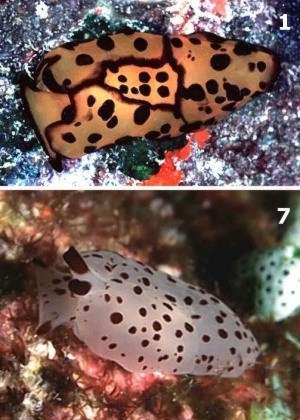
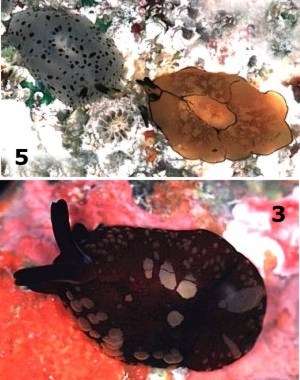
Berthella martensi
(Pilsbry, 1896)
Order: NOTASPIDEA
Superfamily: PLEUROBRANCHOIDEA
Family: Pleurobranchidae
DISTRIBUTION
Tropical Indo-West Pacific
PHOTO
Photos showing colour variation on animals from Okinawa.
#1: Notum 58mm / from 41m; #3: Notum 24mm / from 30m; #5: Notum 25mm & 31mm / from 20m; #7: Photo only, animal not measured / from 8m. PHOTOS: Bob Bolland
This species shows a wide variation in colour, as illustrated here with Bob Bolland's photos. It is characterised by its ability to autotomise (break off) large sections of its mantle when disturbed. The brown ring visible in paler animals marks the breakage point when the animals breaks off its mantle skirt. There is a photo of an autotomised animal elsewhere in the Forum on a page dealing with autotomy.
As with other species of Berthella, this species feeds on sponges. See Clay Bryce's feeding message, and Bob Bolland's feeding photo below.
References:
• Tsubokawa, R. & Bolland, R.F. (1991). Berthella martensi (Pilsbry, 1896), new to the Japanese Notaspidea Fauna. Venus, Japanese Journal of Malacology, 50(3): 184-195.
• Willan, R.C. (1984) The Pleurobranchidae (Opisthobranchia: Notaspidea) of the Marshall Islands, Central-West Pacific Ocean. The Veliger, 27(1): 37-53.
Authorship detailsRudman, W.B., 1998 (October 28) Berthella martensi (Pilsbry, 1896). [In] Sea Slug Forum. Australian Museum, Sydney. Available from http://www.seaslugforum.net/find/bertmart
Related messages
Variants of Berthella martensi from Reunion Island
November 18, 2008
From: Hugues Flodrops
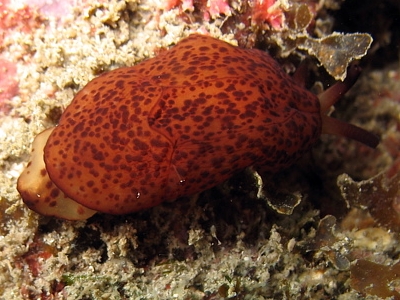
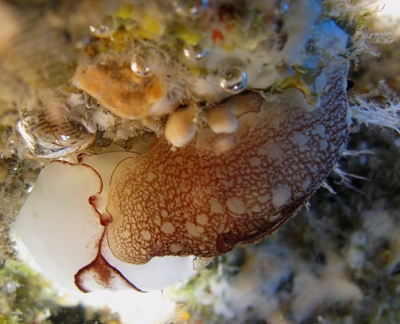
Concerning message #13819:
Hi Bill,
Here are four specimens of Berthella martensi to illustrate colour variability.
Locality: Etang-Salé, 38 metres, Reunion Island, Indian Ocean. Upper Photo: Rocky coast, depth 1 metre, specimen length 25 mm. Date: 3 August 2007. Middle & Lower Photos: "Les Grottes", Etang-Salé, Depth 38 metres, specimen lengths 35 mm (2 white animals), 40 mm (brownish animal). Date 8 November 2008. Photographer: Hugues Flodrops.
I hope it is interesting for the forum.
Regards and thanks.
Hugues.
hugues.flodrops@wanadoo.fr
Flodrops,H., 2008 (Nov 18) Variants of Berthella martensi from Reunion Island. [Message in] Sea Slug Forum. Australian Museum, Sydney. Available from http://www.seaslugforum.net/find/22040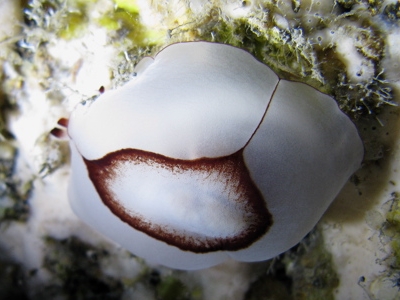
Dear Hugues,
Thanks for these examples of colour variation in this species. In an earlier message of Bob Bolland's [#825], which shows some other variations, one animal was very similar in colour to its food sponge. I note there appears to be a white sponge under the white animal in your lower photo. Perhaps this is another example of colour and food matching? On the right of your photo I can see some little pores but I can't see enough detail to be sure if this is a sponge or a compound ascidian. If you have a photo showing the 'sponge' more clearly it would be interesting to see it.
Best wishes,
Bill Rudman
Berthella martensi feeding
October 5, 2007
From: Bruce Wilkie
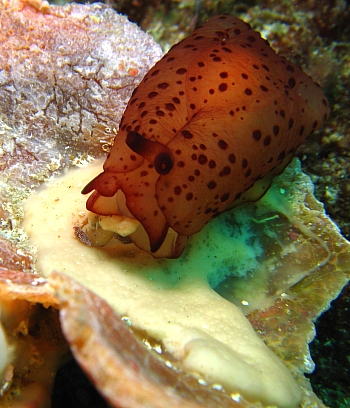
Hi Bill,
I have been sorting through my files looking for feeding records. Here is one I think is Berthella martensi feeding on a sponge. I hope it helps to fill in some gaps.
Locality: Shag Rock, Point Lookout, North Stradbroke Island. , 12mts, Queensland, Australia. , Pacific ocean., 03 June 2007, Rocky reef, hard and soft corals, sponges.. Photographer: Bruce Wilkie.
Many thanks,
Bruce Wilkie.
brucedwilkie@yahoo.com.au
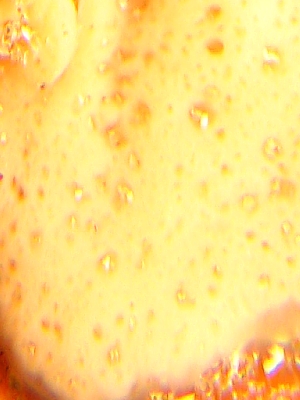
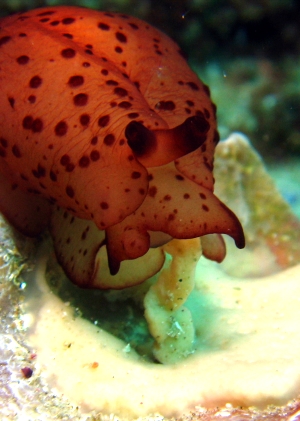
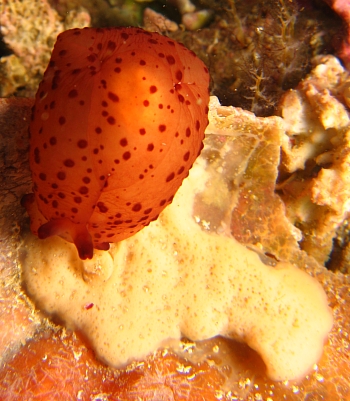
Dear Bruce,
Thanks very much for searching through your slide collection. I am sure there are lots more hidden 'discoveries' in people's photo collections just waiting to be found. This is a quite unequivocal feeding record. All I have to do now its get the sponge positively identified. The only other information we have on this species feeding is a photo from Bob Bolland [#825] of it feeding on a sponge and Clay Bryce's comment [#821] that he had seen it feeding on a sponge, so this is a very useful record.
Best wishes,
Bill Rudman
Berthella martensi from the Seychelles
August 27, 2007
From: David K A Barnes
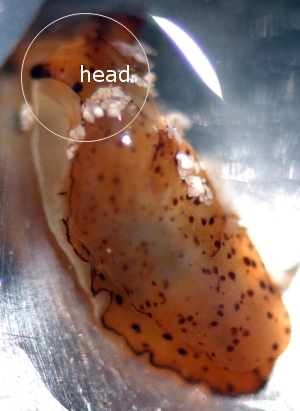
Sorry the two photographs of this are not very good, but does anyone recognise the species.
Locality: Silhouette Is, Intertidal (lower shore), Seychelles, Indian, August 2007, rock and sand. Length: ~15mm. Photographer: Richard Barnes.
Richard Barnes
dkab@bas.ac.uk
Barnes D.K.A., 2007 (Aug 27) Berthella martensi from the Seychelles. [Message in] Sea Slug Forum. Australian Museum, Sydney. Available from http://www.seaslugforum.net/find/20540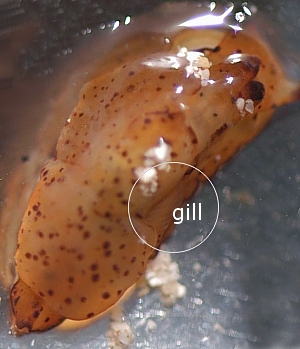
Dear Dave,
Apart from being a bit short of water, one of the problems with identifying this animal is that it is a master of autotomy - that is it can break off majopr parts of its mantle when sidturbed, much like some lizards can cast their tail.
In this animal almost all the outer half of the mantle has been broken off so in the top photo the head [and neck] are clearly visible and in the lower photo we can see part of the gill on the right side.
The gill on the right side is a clue to its identity. It is a pleurobranch, or side-gilled slug, Berthella martensi. Have a look at other photos of the species on the Forum for an idea of which parts of your slug are missing.
Best wishes,
Bill Rudman
Berthella martensi - feeding observation
July 31, 2006
From: Alain BONNET
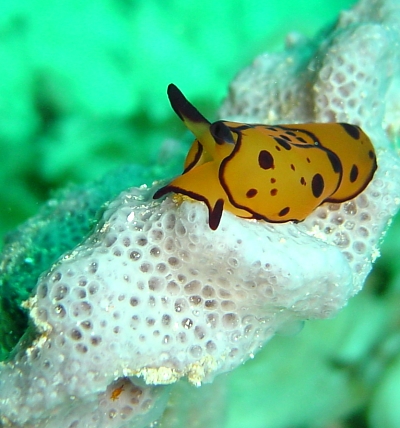
Dear Bill
Here is a picture of Berthella martensi feeding on a sponge.
Locality: Palawan - El Nido, 25 m, Philippines, South China Sea, 20 April 2006. Length: Approx.3 cm. Photographer: Alain Bonnet.
Best Regards
Alain
alain.lm24@neuf.fr
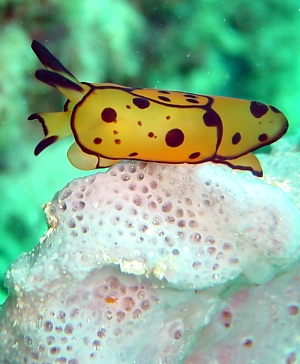
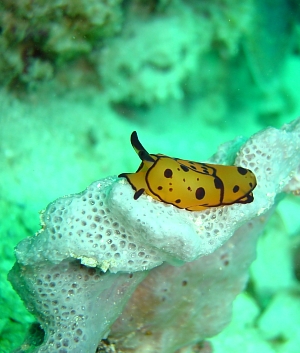
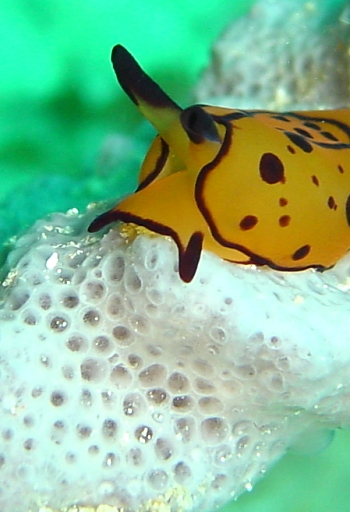
Dear Alain,
This is an interesting photo.The only records we have of Berthella martensi feeding are on the Forum, and they both involve unidentified sponges. Did you actually see the Berthella eating or biting the sponge, or see any damage on the sponge? Did you touch the sponge? It would be good to know if it was hard or soft.
Best wishes,
Bill Rudman
Berthella martensi from the Philippines
June 8, 2006
From: Carlos R. Munda
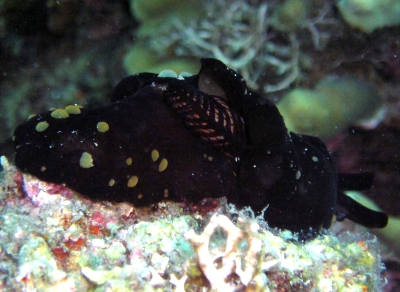
I would like to ask for your assistance in identifying a grasshopper-like nudibranch that we photographed during a dive in davao del sur, in the philippines.
The organism is about 4-5 inches long, dark, smoky brown with yellowish postules all over its body except on the back where it has larger white-ish ones. it has two tubular feelers and a flat 'mouth' on a rounded head part. on its sides were a pair of wing-like extensions which doubled as "sheaths" for what seemed to be its lung part (which looked like feathery leaves).
We found it feeding on under some hard coral in about 20-30 feet of water, and less than 500 meters from the beach.
Locality: Basiawan Bay, Davao Gulf, Sta. Maria Town, 20-30 feet, Davao del Sur, Philippines, pacific, May 3, 2006, shallow reef near beach. Length: 4-5 inches. Photographer: Carlos R. Munda, jr..
Carlos R. Munda
c_munda@yahoo.com
Munda, C. R., 2006 (Jun 8) Berthella martensi from the Philippines. [Message in] Sea Slug Forum. Australian Museum, Sydney. Available from http://www.seaslugforum.net/find/16773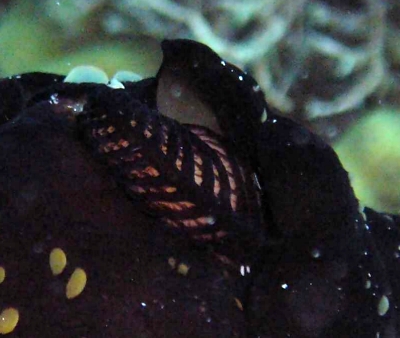
Dear Carlos,
Your animal is Berthella martensi, which is a pleurobranch sea slug. Pleurobranchs are commonly called 'side-gilled slugs' because they have a large single gill on the right side of their body. The feathery structure you mention, and we can see in your photo, is the gill. Have a look at the Fact Sheet, and other related messages, for photos showing the range of colour found in this species, and for information on its biology.
Best wishes,
Bill Rudman
Berthella martensi from Taiwan
April 15, 2006
From: Ching-Yao Chan
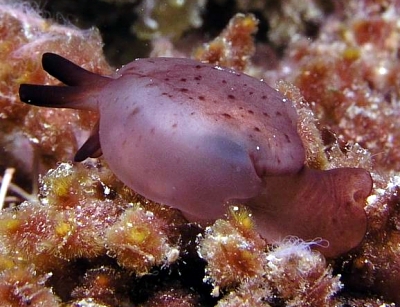
Dear Bill,
I do not know which species this is ? Is it a sacoglossan ?
Locality: Kenting, 9 metres, Taiwan, 15 May 2005, Coral Reef. Length: 40 mm. Photographer: Kuang.
Hope that you can help,
Best wishes,
C.Y.Chan
logic.chan@msa.hinet.net
Chan, C.Y., 2006 (Apr 15) Berthella martensi from Taiwan. [Message in] Sea Slug Forum. Australian Museum, Sydney. Available from http://www.seaslugforum.net/find/16307Dear Ching-Yao,
This is a pleurobranch, not a sacoglossan. It is Berthella martensi. If you look at other messages on this species you will see that it is a species which can drop off bits of its mantle as a defence strategy [see autotomy]. Your animal looks a bit strange because it has lost most of its mantle skirt, no doubt to avoid being mortally wounded by a predator.
Best wishes,
Bill Rudman
Berthella martensi mating
February 11, 2006
From: Kevin Lee
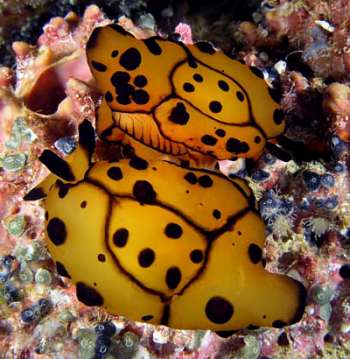
Hi again...
Would like to request assistance on identifying these colorful mating critters... thanks in advance...
Locality: Tomea Island, approx. 20 feet, SE Sulawesi, Indonesia, 01 October 2005, crystal clear reef. Length: circa 1.5 inches. Photographer: Kevin Lee
Best wishes,
Kevin Lee
Fullerton, California
diverkevin@gmail.com
Lee, Kevin, 2006 (Feb 11) Berthella martensi mating. [Message in] Sea Slug Forum. Australian Museum, Sydney. Available from http://www.seaslugforum.net/find/15780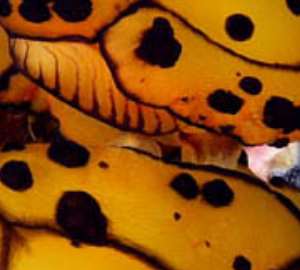
Dear Kevin,
This is the pleurobranch Berthella martensi. I wasn't sure they were actually mating so I 'blew up' your photo [see alongside] to check. They definitely are mating. You can also see the nicely coloured gill - yellow with black edges - along the right side of the upper animal. The position of the gill is why pleurobranchs are often called 'side-gilled slugs'.
Best wishes,
Bill Rudman
Berthella martensi from Queensland
May 25, 2005
From: Daniel J. Foote
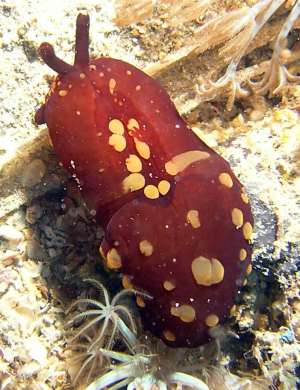
Unsure what it is. Found it crawling around at 27m on the SS Yongala. If someone can help me in the identification it would be much appreciated.
Locality: SS Yongala [east of Townsville, in Great Barrier Reef marine Park], Queensland, Australia. Depth: 27 m. Length: 6-8 cm. 16 May 2005.
Photographer: Daniel Foote
Daniel Foote
pelagic_dan@yahoo.co.uk
Foote, D.J., 2005 (May 25) Berthella martensi from Queensland. [Message in] Sea Slug Forum. Australian Museum, Sydney. Available from http://www.seaslugforum.net/find/13856Dear Daniel,
This is a pleurobranch or 'side-gilled slug' called Berthella martensi. Have a look at the relevant Fact Sheet and attached messages for more information on the species.
Best wishes,
Bill Rudman
White form of Berthella martensi from Reunion Island
May 20, 2005
From: Philibert Bidgrain
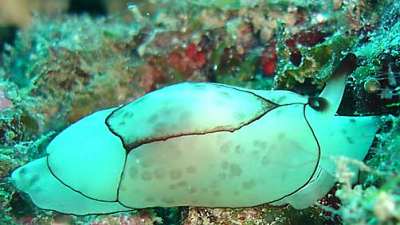
Dear Bill,
Reunion Island sea slugs.
We have found this white form of Berthella martensi. I think that we see in this photo right down the inside of the cylindrical rhinophore on the right side. Is it possible?
This specimen was found and photographed by Emmanuel Eby "Les antennes" at Saint Leu, Reunion Island, Indian Ocean. 12 m, size: 20-25 mm, 04 May 2005.
The usual colour form of Berthella martensi found in Reunion Island is like the Mauritius specimen described in your site by Marina Poddubetskaia (message: #8319 )
Best Regards
Philibert Bidgrain
http://vieoceane.free.fr/runseaslug/indexslug.htm
vieoceane@free.fr
Bidgrain, P., 2005 (May 20) White form of Berthella martensi from Reunion Island. [Message in] Sea Slug Forum. Australian Museum, Sydney. Available from http://www.seaslugforum.net/find/13819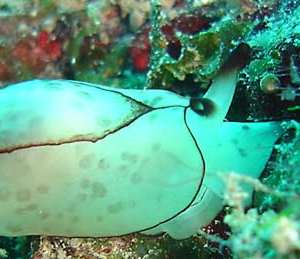
Dear Philibert,
This species certainly seems to have a remarkable colour range. I have seen white animals with brown spots, but not one such as yours. The photo does show the right rhinophore 'end on' so you can see right down into the tube.
Best wishes,
Bill Rudman
Berthella martensi from Indonesia
February 17, 2005
From: Mike Oelrich
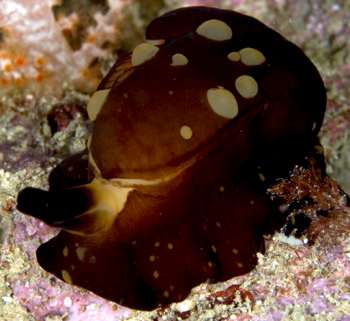
Hi Bill,
I traveled to Indonesia (Raja Empat islands) in November 2004 and can't identify this brown spotted guy. It was large -- about 4 or 5 inches and found in about 40 fsw.
Mike Oelrich
moelrich@cox.net
Oelrich, F.M., 2005 (Feb 17) Berthella martensi from Indonesia. [Message in] Sea Slug Forum. Australian Museum, Sydney. Available from http://www.seaslugforum.net/find/13142Dear Mike,
This is Berthella martensi. You will see from other mesages on the Forum that this species is very variable in colour.
Best wishes,
Bill Rudman
Re: Berthella martensi from Thailand
December 11, 2003
From: Erwin Köhler
Dear Bill,
Concerning the size of the animal in Mark & Dana's recent message the mystery sea slug from Klaus Stark, [see my earlier message] which was later identified as Berthella martensi, also was at least 12cm. I saw it with my own eyes and think it might have been even larger.
Regards,
Erwin
Erwin@Philippine-Sea-Slugs.com
Köhler, E., 2003 (Dec 11) Re: Berthella martensi from Thailand. [Message in] Sea Slug Forum. Australian Museum, Sydney. Available from http://www.seaslugforum.net/find/11664Thanks Erwin,
I missed that. It's nice then to have a second observation showing this species grows substantially larger than previously thought
Best wishes
Bill Rudman
Berthella martensi from Thailand
December 8, 2003
From: Mark Atwell & Dana Rayfield
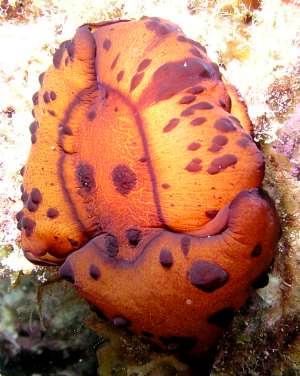
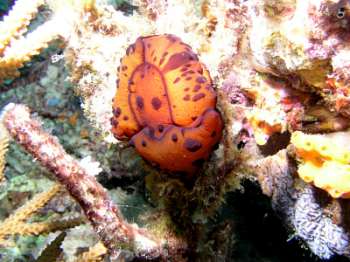
Dear Bill,
We came across this 12cm monster Berthella martensi at Lucy's Reef off Phuket in Thailand a couple of weeks ago.
We didn't know what it was at the time, partly due to it being inactive (pity!). As you can see it was 'resting' vertically on some well-weathered reef at about 18-20m a few 10's of meters from a sandy plain.
Note the white/cream coloured areas between the segments.
Mark Atwell & Dana Rayfield
mark_atwell@hotmail.com
Atwell, M. & Rayfield, D., 2003 (Dec 8) Berthella martensi from Thailand. [Message in] Sea Slug Forum. Australian Museum, Sydney. Available from http://www.seaslugforum.net/find/11634Dear Mark & Dana,
Thanks for the photo. Richard Willan (1984) records a specimen reaching 73mm when fully extended as the largest known specimen, so your animal, 120mm long when not extended is about twice the reported length for this species. I'm afraid I can't see the 'white/cream coloured areas between the segments' that you mention. There is a translucent white object on the lower right but I'm not sure what it is. It could be the end of the gill, which sits on the right side under the mantle but I'm can't be sure
• Willan, R.C. (1984) The Pleurobranchidae (Opisthobranchia: Notaspidea) of the Marshall Islands, Central-West Pacific Ocean. The Veliger, 27(1): 37-53.
Best wishes
Bill Rudman
Berthella martensi from Mauritius
November 15, 2002
From: Marina Poddubetskaia
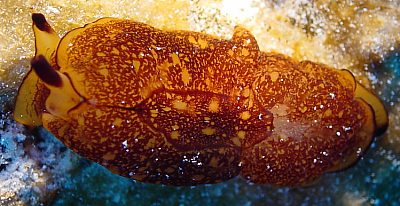
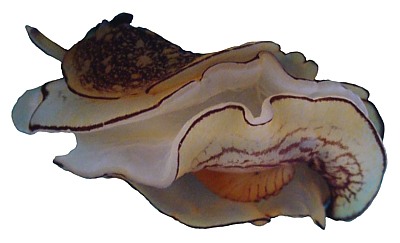
Dear Bill,
I found this nice notaspid in Mauritius. It was in walk in an open area. Could you help me to identify it, please. Is it a species of Pleurobranchus? Which are the distinguishing characteristics of the genus Pleurobranchus?
As you could easily see, this animal was damaged on the left side of the head (rhinophore + oral tentacle). At the beginning, I thought the black tip of the right oral tentacle was an abnormality, but finally I believe this species has oral tentacles naturally tipped with black.
Pereybere, Mauritius, Indian Ocean. Site: Grand Aquarium. Depth: 11m. Size: 35-40mm. October 16, 2002
Photos: Marina Poddubetskaia - Nembro website
Best wishes,
Marina.
nembro@nembro.info
Poddubetskaia, M., 2002 (Nov 15) Berthella martensi from Mauritius. [Message in] Sea Slug Forum. Australian Museum, Sydney. Available from http://www.seaslugforum.net/find/8319Dear Marina,
This is another colour variant of Berthella martensi. Concerning the distinguishing features of Pleurobranchus, I am in the process of preparing some keys to add to the Forum to help identify the major opisthobranch groups. If you can wait a little while, the genera of the Notaspidea will definitely be included.
Best wishes,
Bill Rudman
Sea Hares? in Pulau Aur, Malaysia
September 30, 2002
From: Barbara Phua
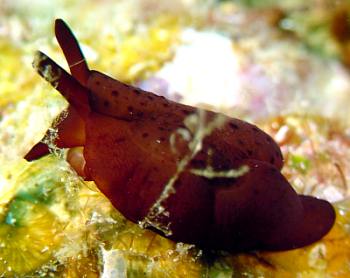
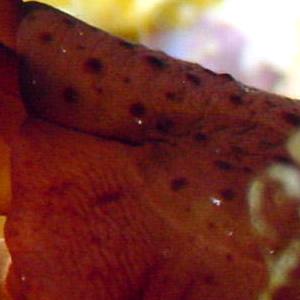
Hi Dr Rudman
Sea Hares in Pulau Aur, Malaysia
Are these seahares? I read somewhere that they are only found in Australia. I was surprised to spot this one at Teluk Teluran, in Pulau Aur, Malaysia.
Barbara Phua
babala.pan@pacific.net.sg
Phua, B., 2002 (Sep 30) Sea Hares? in Pulau Aur, Malaysia. [Message in] Sea Slug Forum. Australian Museum, Sydney. Available from http://www.seaslugforum.net/find/8073Dear Barbara,
Sea Hares are found in most parts of the world. Some species are only found in some regions, but others, such as Aplysia dactylomela, have very wide distribution. However your animal is a Sea Slug, but not a Sea Hare. It is Berthella martensi, which is notaspidean, sometimes called a 'Side-gilled Slug' because it has a large gill hidden on the right side of the body between the mantle and the foot. This psecies is quite variable in colour, and in brown animals the dark brown spots, which are so characteristic of this species, are gard to see [see lower photo]
Best wishes,
Bill Rudman
Berthella martensi from Tufi, Papua New Guinea
October 23, 2001
From: Des Paroz
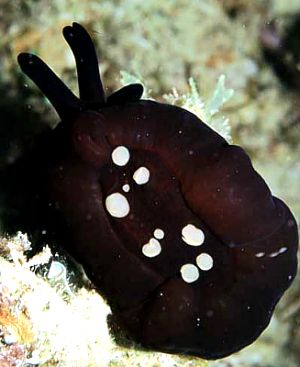
Hi Bill
This photo is what I think is Berthella martensi. Found in Tufi Fjord, Papua New Guinea, September 2001, in an area covered with large amounts of "cabbage patch" style coral.
Best regards
Des
des@paroz.com
Paroz, D., 2001 (Oct 23) Berthella martensi from Tufi, Papua New Guinea. [Message in] Sea Slug Forum. Australian Museum, Sydney. Available from http://www.seaslugforum.net/find/5453Thanks Des,
Bill Rudman
Berthella martensi from the Solomons
October 4, 2001
From: Bruce Potter
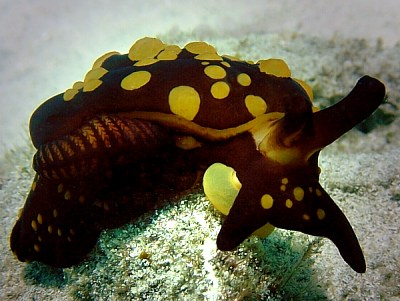
Bill,
I found this beautiful Berthella martensi on 29 September, 2001. It was about 65mm long. It was on sand, just at the edge of a rubble patch in about 4 meters. This is on a dive site just on the edge of Honiara, in the Solomon Islands. I am assuming that it has lost part of it's mantle because the gills are visible.
Regards
Bruce Potter.
bruce.potter@adventist.org.sb
Potter, B., 2001 (Oct 4) Berthella martensi from the Solomons. [Message in] Sea Slug Forum. Australian Museum, Sydney. Available from http://www.seaslugforum.net/find/5382Thanks Bruce,
This species certainly seems to have a great variation in colour. Looking at the photos we now have on the Forum it seems the yellow (or whitish) spotted form is characterised by having the anterior foot the same colour as the spots - in the case of your animal, bright yellow. As you suggest it seems to have autotomised the right side of the mantle, which makes the gills clearly visible.
Best wishes,
Bill Rudman
Berthella martensi from NE Sulawesi
August 10, 2001
From: Jim Anderson
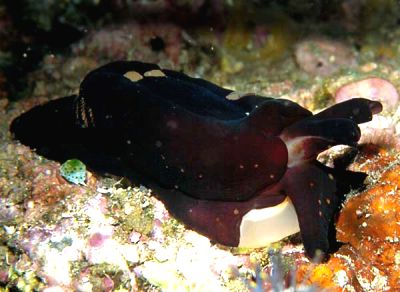
Dear Dr. Rudman,
The attached was photographed, not very well, at 24 metres on Angel's Window, Lembeh Strait NE Sulawesi on 18 June. it is approx 65 mm long and was sitting on a recessed ledge of the reef.
Regards,
Jim A
jander4454@aol.com
Anderson, J., 2001 (Aug 10) Berthella martensi from NE Sulawesi. [Message in] Sea Slug Forum. Australian Museum, Sydney. Available from http://www.seaslugforum.net/find/4994Dear Jim,
This is one of the many colour forms of Berthella martensi. You'll see it has an identical white patch at the front of the foot as in Mary Jane Adams' photo.
Best wishes,
Bill Rudman.
Berthella martensi with tubercles
February 27, 2001
From: Mary Jane Adams
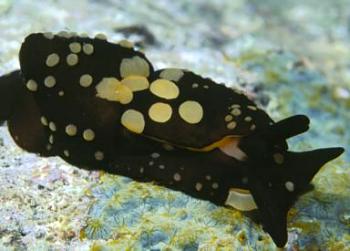
Hi Bill,
This is a picture I took in Palau in February, 1991. Is this Berthella martensi with yellow tubercles or something else?
Best regards,
Mary Jane
divepng@yahoo.com
Adams, M.J., 2001 (Feb 27) Berthella martensi with tubercles. [Message in] Sea Slug Forum. Australian Museum, Sydney. Available from http://www.seaslugforum.net/find/3867Dear Mary Jane,
I have never seen one this colour but it certainly looks like Bob Bolland's photo #3 from Okinawa and Erwin Koehler's message from Cebu Island in the Philippines.
It is certainly a very variably coourerd species.
Best wishes,
Bill Rudman
Autotomy in Berthella martensi
January 7, 2000
From: Mary Jane Adams
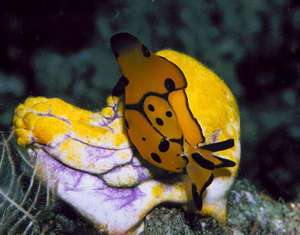
Dear Bill,
I found this Berthella martensi at 10 meters on a the lagoon side of a barrier reef in the Florida Group of the Solomon Islands. It is the first one I have seen and so I took a lot of photos of it. When I was reviewing my photos I noticed that the left side panel of the mantle is missing. I read in your Forum that this pleurobranch can shed sections of its mantle as a defence mechanism, but I was wondering how common it is to find them this way.
Thanks for keeping up the Forum even on your holiday!
Mary Jane
mjadams@earthlink.net
Adams, M.J, 2000 (Jan 7) Autotomy in Berthella martensi. [Message in] Sea Slug Forum. Australian Museum, Sydney. Available from http://www.seaslugforum.net/find/1730Dear Mary Jane,
I'm not sure how often B. martensi breaks off parts of its mantle. As it can regrow the missing section there is no permanent record of the event unlike a lizard whose second tail is usually a poor imitation of the original.
I have never found B. martensi in large numbers. Perhaps someone who has, could give us some idea of how common 'breakages' occur.
Best wishes,
Bill Rudman.
Berthella martensi - pics and food info
May 1, 1999
From: Bob Bolland
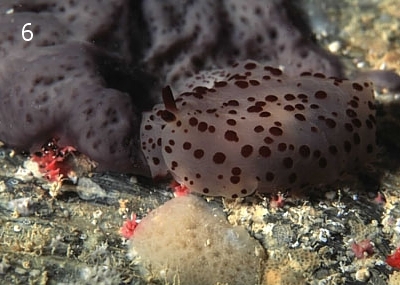
Hi Bill:
In re the recent thread on Berthella martensi I thought I'd post a few images of some of the Okinawan material showing some of the color variations, as well as one of the animals found on its sponge host.
001: Notum 58mm / from 41m
003: Notum 24mm / from 30m
005: Notum 25mm & 31mm / from 20m
006: Photo only, animal not measured / from 3m (Found feeding on the sponge, as pictured)
007: Photo only, animal not measured / from 8m
Cheers,
Bob
bolland@imicom.or.jp


Dear Bob,
Thanks very much for the pictures. That solves my lack of pictures and Photo 3 solves Erwin Koehler's mystery black pleurobranch with yellowish pustules.
Bill Rudman.
Berthella martensi - feeding observation
April 30, 1999
From: Clay Bryce
Hi Bill,
Following on my message about Pleurobranchus forskalii. I have pics of Berthella martensi feeding at night on a sponge. [Ashmore Reef, Kimberleys, north western Australia]
Cheers,
Clay Bryce
W.A. Museum
Perth.
brycec@museum.wa.gov.au
Bryce, C., 1999 (Apr 30) Berthella martensi - feeding observation. [Message in] Sea Slug Forum. Australian Museum, Sydney. Available from http://www.seaslugforum.net/find/821Dear Clay,
If you get the chance, it would be nice to have a scan of your photo to put on the Forum. To my knowledge, your record about this species feeding on sponges is the first time we have had any information on the food of Berthella martensi. Berthella plumula and some Mediterranean species are reported by European workers to feed on the sponge Oscarella lobularis and Richard Willan has reported finding sponge spicules in the faeces of two New Zealand species. A good review of pleurobranch diets is:
Willan, R.C. (1984). A review of diets in the Notaspidea (Mollusca: Opisthobranchia). Journal of the Malacological Society of Australia, 6(3): 125-142.
Bill Rudman.
Rudman, W.B., 1999 (Apr 30). Comment on Berthella martensi - feeding observation by Clay Bryce. [Message in] Sea Slug Forum. Australian Museum, Sydney. Available from http://www.seaslugforum.net/find/821Re: Mystery from the Philippines
April 22, 1999
From: Erwin Koehler
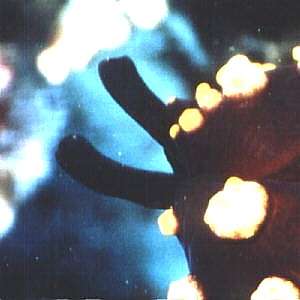
Bill,
Here is a detail of the Philippine mystery - the rhinopores of it.
I was just going to rescan the photo as I had a look at Debelius ... At page 155 middle/right is the mystery-slug: Berthella martensi
I didn't know that this critter can grow so large and look like this way - all photos at the web show it yellow with black spots, this one looks like a negative: black with yellow spots!
Thanks for all your help!
Erwin
Medslugs.Koehler@t-online
Koehler, E., 1999 (Apr 22) Re: Mystery from the Philippines. [Message in] Sea Slug Forum. Australian Museum, Sydney. Available from http://www.seaslugforum.net/find/796Dear Erwin,
I had wondered whether there were two 'tentacles' or one and a shadow. Certainly if there are two, as your enlargement suggests then they look like a pair of pleurobranch rhinophores as illustrated for Berthella stellata.
One problem is I don't know of any species with that colour pattern and raised tubercles. I find it hard to accept that it is a color form of Berthella martensi, which ranges in colour from a yellow to white background with dark brown or black spots and lines. The back is smooth with no raised tubercles. I'm afraid the only decent photo I have is of a white animal in the page on autotomy.
If anyone else has any ideas please share them with us.
Bill Rudman.
Re: Mystery from Philippines
April 22, 1999
From: Bill Rudman
Dear Erwin,
I didn't realise from your message that Debelius actually had a photo of the same colour form. Having now looked at the book I agree that your 'mystery' is the same as his 'colour form' of Berthella martensi. It now waits to be seen if it is a colour variant of B. martensi. It certainly is way outside the range of colour variation I am familiar with. Perhaps someone can help?
Bill Rudman.
Rudman, W.B., 1999 (Apr 22). Comment on Re: Mystery from Philippines by Bill Rudman. [Message in] Sea Slug Forum. Australian Museum, Sydney. Available from http://www.seaslugforum.net/find/797Mystery from the Philippines
April 21, 1999
From: Erwin Koehler
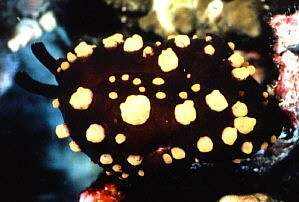
Bill,
This photo was made by my buddy Klaus Stark - email:K.Stark@t-online.de
It was taken at:
Philippines, Cebu Is., Moalboal housereef, 18m depth, March 1999, size about 12cm.
Erwin.
Medslugs.Koehler@t-online
Koehler, E., 1999 (Apr 21) Mystery from the Philippines. [Message in] Sea Slug Forum. Australian Museum, Sydney. Available from http://www.seaslugforum.net/find/794Dear Erwin,
I think this is not a nudibranch but an ovulid or 'False Cowry' which get their family name Ovulidae from often having an egg-shaped shell, and their common name from looking like a cowry (Cypraeidae) to which they are not closely related.
Ovulids usually hide their shells beneath large mantle flaps which are often brightly coloured. When I get a chance I'll prepare some information on them because they have interesting parallels with nudibranch evolution.
What puzzles me though are the two black 'tubes?' at the front of the animal. Is one a siphon? Is the other one a shadow? Are they enlarged tentacles? Perhaps there are two animals here? Although I try and display images at this size (300 pixels wide), so they load fairly quickly, it would be better, if possible, to send pictures to me a bit bigger so I can look for any important details which might help me in identifying the animals.
Best wishes,
Bill Rudman.
